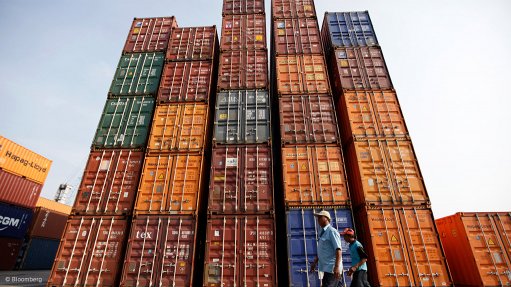
Photo by: Bloomberg
As Barclays on Tuesday revealed a conservative 2.2% gross domestic product (GDP) forecast for 2014 – a growth prediction notably lower than that of its peers – the banking group’s macroeconomist for Africa Peter Worthington said near-term adjustments to the current account deficit, which stood at 5.1% of GDP in the fourth quarter of 2013, would likely come from import compression as demand remained weak and new price incentives encouraged the use of domestically produced alternatives.
This would occur in industries in which domestic alternatives were available, such as the automotive, textiles, plastics and chemicals sectors, he said at a presentation of the bank’s ‘South Africa Quarterly Perspectives Q2’ report in Johannesburg.
In contrast, essential imports of capital equipment – particularly for the public infrastructure build programme – as well as various intermediate goods and crude oil were highly price inelastic, given largely that many of these imported goods had no domestic alternative that would allow a rapid compression in import demand.
“The public infrastructure programme will [last] for a decade and will continue to require capital equipment from abroad, although the government is pushing for increased localisation of manufacturing, for example, in the renewable energy sector.
“It has been suggested that South Africa has passed the peak of its capital equipment exports, but this is hard to prove. We note that imports of machinery and capital goods tend to be lumpy and hard to predict,” Worthington said.
The bank, which is affiliated to Absa Capital locally, expected “some” improvement in the net services trade balance, stemming largely from the tourism “boom”, but cautioned that other invisible outflows, such as the current transfers to other countries in the Southern African Customs Union – which was worth some 1% of GDP a year – should remain elevated and may even trend up, given increased import volumes in recent years.
“Overall, the February trade data raises downside risks to our forecast of an unchanged current account deficit of 5.8% of GDP in 2014, but we would only be markedly more optimistic about the likely pace of adjustment if February’s encouraging import and export numbers are consistently sustained.
“For now, we think the crux of our story – that current account adjustment will be slow and gradual rather than a sudden inflection point – remains broadly valid,” Worthington noted.
CAPACITY CONSTRAINTS
Expanding on the bank’s somewhat downcast growth forecast for the year, he elaborated that capacity constraints in roads, ports, railways and water supply remained a drag on South Africa’s overall growth outlook.
“No capacity constraint is as fundamental and more pressing than the energy shortage,” Worthington averred, blaming the “tight supply situation” on parastatal Eskom’s failure to add big-generation power capacity to the grid since “well before” the global financial crisis.
“This gap is an increasingly tight constraint on economic activity. Once the country’s energy constraints are relaxed, South Africa’s growth rate will rise and its external vulnerabilities will lessen,” he said.
HOUSEHOLD CONSUMPTION
Meanwhile, Barclays expected household consumption to grow just 2.2% in 2014 compared with the post-recession low of 2.6% in 2013 when, somewhat “counter intuitively”, consumer spending on durables and semidurables showed resilience but spending on nondurables and services slowed further.
Worthington said the consumption outlook remained “hobbled” by rising inflation and rate hikes, which could erode consumers’ real disposable-income spend.
Furthermore, bank lending to households had slowed “sharply” to 5.2% year-on-year in February – the weakest rate of growth since 2010.
“One big question mark for household consumption is also the employment situation. We think employment creation is going to be quite pedestrian, but there could be an upside potential to our consumption forecast,” Worthington commented.
TRIMMED GOVERNMENT SPEND
Fiscal restraint would limit the ability of government to support growth, he said, as National Treasury committed to keeping real noninterest government expenditure growth to “just” 2% a year.
The last few years had seen a “welcome and surprising” acceleration in private fixed investment spend to 5.5% in 2013 but, despite government’s infrastructure build programme, implementation was “challenging” and budgets were underspent.
“We think business confidence will likely continue to constrain government spending in the near term at least. The deterioration in the Bureau for Economic Research’s business confidence index in the first quarter of the year to 41 is not an encouraging sign. We, thus, forecast overall fixed investment spending growth of 3.6% in 2014 and 3.8% in 2015,” Worthington stated.
He added that Barclays saw an upside potential to these spending growth forecasts should government “aggressively” intensify its implementation of the National Development Plan after the May 7 national elections, therewith directly boosting its own investment and that of private business indirectly.
“[This could occur] if government significantly intensifies its [policy] reform drive after the elections, but our base-case scenario for policy is that it will be largely ‘more of the same’ in the next administration,” Worthington noted.